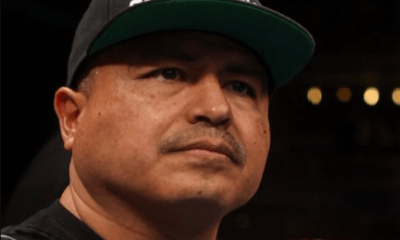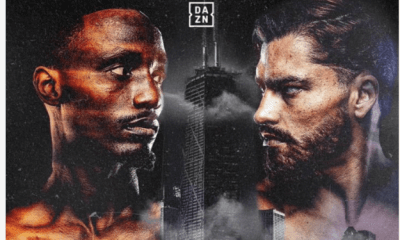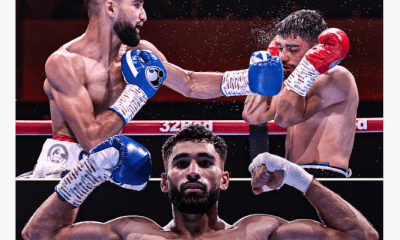Featured Articles
How O’Shaquie Foster’s Long, Dark Night Led to A Brighter Future

O’Shaquie Foster was sitting alone in the dark on an unforgiving concrete floor in a Texas jail cell. Sweltering heat. No windows. No lights. The power had been out for over half a week now, and there was no window by which a gentle breeze might offer even the slightest comfort.
“I couldn’t even see my hands,” remembered Foster. “They were handing us food, and I couldn’t even eat it. It was so crazy. It was so bad.”
Foster was in for a shooting incident that had left one man wounded and the other, Foster, in jail. Being trapped inside a cage is bad enough, but Hurricane Harvey had made things so much worse that summer after it tore through the Texas Gulf Coast like a runaway jackhammer in the hands of a madman scattering ruthless devastation all around the state.
To make matters worse, Orange County officials had been divorced enough from compassion, or at least languishing far enough away from the sound shores of reason, that they hadn’t seen fit to evacuate the prisoners to safer quarters.
But sometimes, even in the most dire circumstance, all the universe conspires to give a person the opportunity to discover a new point of view, one that might otherwise have gone unseen.
So here in this horrible moment was where Foster, stuck in the stuffy darkness made worse by the third 500-year flood in just three years, at long last considered what he had been doing with his one and only life before and what he could have been doing with it instead.
“It just opened my eyes,” said Foster, who just a few days prior had watched Terence Crawford become the undisputed junior welterweight champion of the world on the jailhouse community television set.
Foster said he knew he had that kind of ability, the kind that Crawford used to fight out of Nebraska. But there was Crawford on a grand stage making the most out of his life, and here sat Foster among the prisoners.
Foster had been an alternate for the 2012 Olympic team. Just 17 years old at the time of the Olympic Trials, Foster, a fighter from Orange, Texas, aka the tiny East Texas town hardly any good boxer had ever come from, almost did the unthinkable when he came within three points of upsetting Joseph Diaz to make the team.
To this day, Foster still believes he deserved to win that fight. While it would have been an upset, it wouldn’t have been considered a fluke. After all, Foster had won nearly 200 bouts as an amateur, was a two-time national Jr. Golden Gloves champion, a five-time Ringside national champion and the 2011 PAL national champion.
But coming oh-so-close to beating Diaz, and feeling as if maybe USA Boxing officials had purposely made sure he didn’t, Foster declared himself a professional with no real connections to that world and no big plan.
“Yeah, I was pretty salty.”
To make matters worse, Foster’s local gym in Orange closed right after the Olympic trials had ended. So as Foster was attempting to launch his professional fighting career, he had to do so with a very limited support network and virtually no place to train.
Foster briefly moved to Houston, but after winning his first few professional fights, he ended up back in his hometown again where he admitted he really didn’t focus all that much on his craft.
“I wasn’t training like I was supposed to,” said Foster. “I was still stuck in the hood where I grew up, but I was still taking fights and I was winning for as long as I could.”
Sometimes an unexpected setback can lead to a personal breakthrough. Other times, it takes multiple difficulties for a person to make whatever connection he or she needs to make that giant leap forward.
For Foster, despite losing in 2015 to Samuel Teah and in 2016 to Rolando Chinea, the fighter didn’t really make his big personal decision to turn his life around until that long, dark night in a Texas jail cell. It was at that moment that Foster decided what he would do the minute he got out of there.
“I came straight here,” said Foster, pointing down at the ground while standing next to a well-worn punching bag at Main Street Boxing and Muay Thai Gym in Houston.
“It changed my whole life. I stayed away from the hood. I didn’t go to my hometown for like a year. It was a while before I went back, and I just changed my whole environment.”
Foster has since become one of boxing’s best-known spoilers. Trained by Bobby Benton and Aaron Navarro, the now completely dedicated fighter has won five straight bouts, including twice as an underdog, most recently upsetting previously undefeated Spanish prospect Jon Fernandez.
That win netted Foster the WBC silver junior lightweight title, along with a top ten ranking from that organization and a well-deserved homecoming bout just 30 minutes west of his hometown in Beaumont in February. More importantly, this newfound dedication to living his best life, one that includes fully devoting himself to professional boxing, is turning him into the fighter he always believed he could be.
And all that Foster has planned next is more of the same.
“We’re trying to take over one fight at a time,” said Foster.
Benton said Foster reminded him a lot of his other star pupil, 140-pound titleholder Regis Prograis. In fact, the 40-year-old trainer said he remembered meeting both fighters when they were young, and that he knew upon seeing each that they possessed real potential.
“I’ve known O’Shaquie since he was eight years old,” said Benton. “Even back then, I knew he was special.”
Benton isn’t one to overpromote, so if he says Foster, a two-loss fighter from Orange, can seriously compete for a world title at 130 pounds; he really believes it.
“This kid’s really got it,” said Benton. “Listen, at the point he’s at right now, nobody is going to beat him.”
Just two years ago, that kind of talk about Foster would be laughable to anyone but Foster, who said he always believed he could make it, and maybe his manager, Keith Mills, who Foster said always stuck by him even during difficult times.
And who knows what might happen? Maybe someday soon, Foster will be the one on a grand stage helping inspire another lost and wayward soul who needs to make some really big changes in his life.
Maybe Foster can really be like Crawford.
“Nah,” said Foster, owning his incredible power of self-belief, that same energy which gave him hope during an incredibly difficult situation two years ago and led him out of the darkness into the light of a brighter future.
“I’m going to be better than that. I’m better than Terence Crawford.”
Check out more boxing news on video at The Boxing Channel
To comment on this story in The Fight Forum CLICK HERE
-

 Featured Articles4 weeks ago
Featured Articles4 weeks agoResults and Recaps from New York Where Taylor Edged Serrano Once Again
-

 Featured Articles1 week ago
Featured Articles1 week agoThe Hauser Report: Zayas-Garcia, Pacquiao, Usyk, and the NYSAC
-

 Featured Articles3 days ago
Featured Articles3 days agoOscar Duarte and Regis Prograis Prevail on an Action-Packed Fight Card in Chicago
-

 Featured Articles3 weeks ago
Featured Articles3 weeks agoResults and Recaps from NYC where Hamzah Sheeraz was Spectacular
-

 Featured Articles4 weeks ago
Featured Articles4 weeks agoFrom a Sympathetic Figure to a Pariah: The Travails of Julio Cesar Chavez Jr
-

 Featured Articles2 weeks ago
Featured Articles2 weeks agoManny Pacquiao and Mario Barrios Fight to a Draw; Fundora stops Tim Tszyu
-

 Featured Articles4 weeks ago
Featured Articles4 weeks agoPhiladelphia Welterweight Gil Turner, a Phenom, Now Rests in an Unmarked Grave
-

 Featured Articles2 weeks ago
Featured Articles2 weeks agoArne’s Almanac: Pacquiao-Barrios Redux




















